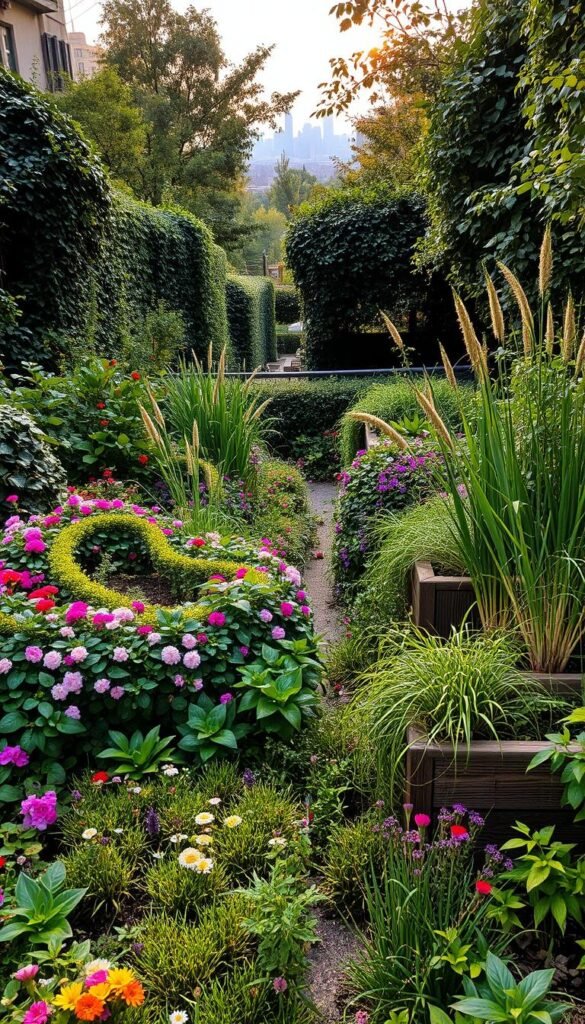What if your urban green space could thrive without strict plans or endless upkeep? Imagine tossing a mix of seeds into a patch of soil and watching life unfold in wild, vibrant patterns. This is the heart of chaos gardening—a laid-back method that turns rigid rules into creative freedom.
Perfect for small balconies, rooftops, or even windowsills, this approach lets you work with nature rather than against it. You’ll scatter hardy seeds and native species, then step back as sunlight, rain, and local pollinators do the heavy lifting. No fancy tools or expensive setups required—just curiosity and a willingness to embrace surprises.
Why does this resonate with city dwellers? It’s affordable, adaptable, and ideal for busy schedules. Whether you’re growing herbs, flowers, or veggies, the mix of plants creates a self-sustaining ecosystem. Plus, you’ll join a growing community of gardeners who share tips on TikTok and Instagram, proving that beauty thrives in spontaneity.
Ready to start? This guide walks you through sourcing seeds, choosing the right spot, and celebrating the quirky results. Remember: there’s no “failure” here—only lessons learned and unexpected joy. Your concrete jungle is about to get a lot greener.
Getting Started with Urban Chaos Gardening
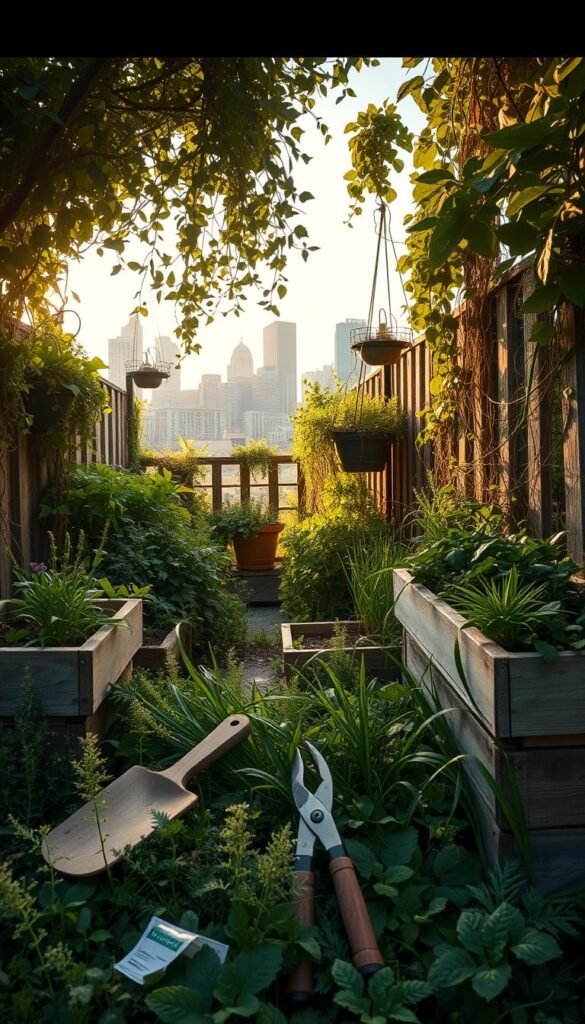
Forget perfect rows and precise watering schedules—there’s a freer way to grow. This method isn’t about controlling every leaf or bloom. Instead, it’s about partnering with your environment to create a dynamic, ever-changing green space.
Understanding the Basics
At its core, this approach celebrates randomness. You’ll toss a blend of seeds—think wildflowers, herbs, or quick-growing veggies—into prepared soil and let them compete for space. Unlike traditional plots, there’s no need for grids or color coordination. Nature decides which plants thrive based on sunlight, moisture, and your local climate.
Start by choosing a spot that gets at least four hours of daily sun. Even a cracked sidewalk planter or old storage bin works! Test your soil’s drainage with a simple trick: pour water on it. If it soaks in within 10 minutes, you’re golden. If not, mix in compost or sand to loosen it up.
Why Urban Chaos Gardening?
City environments often lack biodiversity, but this style fixes that. Hardy plants crowd out weeds, while varied root depths prevent soil erosion. You’ll spend less time fussing over individual sprouts and more time enjoying your mini-ecosystem.
Newbies often worry about “messy” results. But that’s the point! Unexpected combinations—like marigolds tangling with basil—create natural pest control and visual charm. Just avoid invasive species, and let curiosity guide you.
Chaos Gardening 101: Embracing Natural Growth in City Spaces
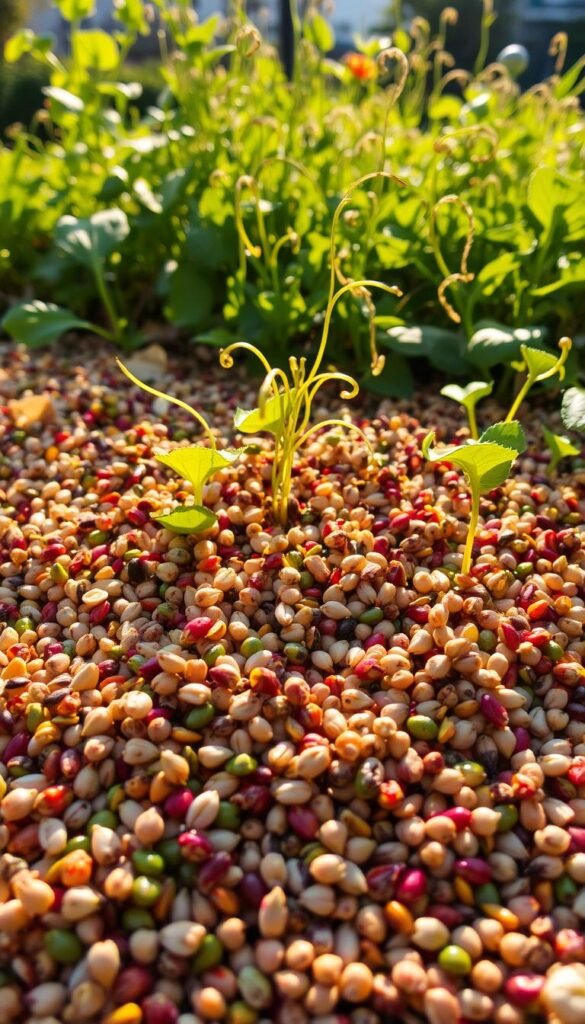
Who says urban gardens need strict layouts? Let randomness be your guide. This method turns empty patches into lush, self-sustaining ecosystems by trusting nature’s rhythm. Just scatter a mix of seeds—wildflowers, herbs, or leafy greens—and watch them weave a living carpet over bare soil. No grids, no stress.
Different seed combinations create unique textures and colors. For example, clover adds nitrogen to the ground, while marigolds deter pests naturally. Pair quick-sprouting radishes with slower-growing sunflowers for staggered visual interest. The result? A dynamic tapestry that shifts with the seasons.
| Seed Type | Benefits | Best For |
|---|---|---|
| Wildflowers | Attract pollinators | Balcony boxes |
| Herbs (e.g., basil, thyme) | Edible & aromatic | Windowsills |
| Leafy greens (e.g., kale, spinach) | Fast harvest | Rooftop plots |
Imperfections aren’t flaws here—they’re proof of life adapting. A crooked stem or uneven bloom cluster tells a story of resilience. As highlighted in chaos gardening basics, this approach reduces maintenance while boosting biodiversity.
Your concrete surroundings will hum with energy as bees visit tangled flower clusters and birds nest in overgrown corners. For more inspiration on blending function with wild beauty, explore urban wild aesthetics. Up next: we’ll dive into the mindset behind this movement and how to apply it step-by-step.
Exploring the Philosophy Behind Chaos Gardening

What if your garden could teach you resilience? This style thrives on unpredictability, celebrating cracks where poppies bloom and vines that climb fire escapes. It’s not just about growing things—it’s a mindset shift that redefines success.
Embracing a Wild Approach
Forget manicured lawns. Here, dandelions share space with kale, and clover carpets the soil as living mulch. These tangled layers suppress weeds while sheltering beetles and worms. One Brooklyn gardener noticed sparrows nesting in her overgrown mint patch—a happy accident she’d never planned.
Urban growers report fewer pests when diverse plants mingle. “My basil thrives next to wild strawberries,” says Marco from Seattle. “I didn’t arrange it—they just found harmony.”
The Benefits of Letting Nature Lead
When you let nature steer, you’re building habitats, not just plots. Native violets attract bees, while fallen leaves become compost. Your role shifts from director to collaborator.
This method saves time, too. No daily watering—rain does the work. Plants self-seed, creating next year’s surprises. As one Detroit enthusiast puts it: “My chaos garden feels alive. It’s not perfect, but it’s always evolving.”
Ready to try? Scatter seeds where they land. Watch sunlight paint patterns through leaves. Remember: every “mess” is a story waiting to unfold.
Recognizing Your Urban Garden Space
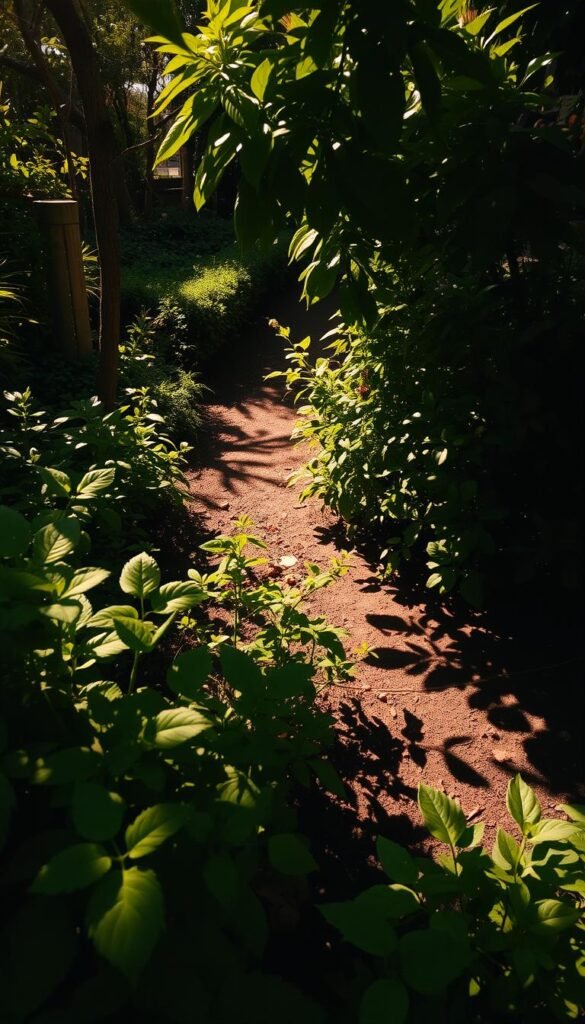
Your urban patch has secrets waiting to be discovered—if you know where to look. Before scattering seeds, take time to decode your unique environment. This isn’t about perfection—it’s about unlocking hidden potential.
Assessing Sunlight and Shade Patterns
Start by tracking how light moves through your space. Spend a day noting when shadows creep across balconies or rooftops. Full-sun areas (6+ hours) suit tomatoes and lavender, while shade-loving mint thrives under fire escapes.
Next, test your soil. Squeeze a handful—if it crumbles, add compost. If it stays clumped, mix in sand for drainage. No fancy tools needed—your hands tell the story.
| Area Type | Light Exposure | Plant Suggestions |
|---|---|---|
| Sun Zones | 6+ hours daily | Zinnias, rosemary, peppers |
| Mixed Light | 3-5 hours daily | Basil, kale, marigolds |
| Shade Patches | Less than 3 hours | Mint, ferns, spinach |
Group gardening zones by their conditions. A sunny windowsill becomes an herb haven, while damp corners host ferns. This smart spacing lets plants support each other naturally.
Remember: Your observations today shape tomorrow’s wild beauty. Once you’ve mapped light and soil, you’re ready to let nature paint outside the lines.
Selecting the Right Seeds and Mixes
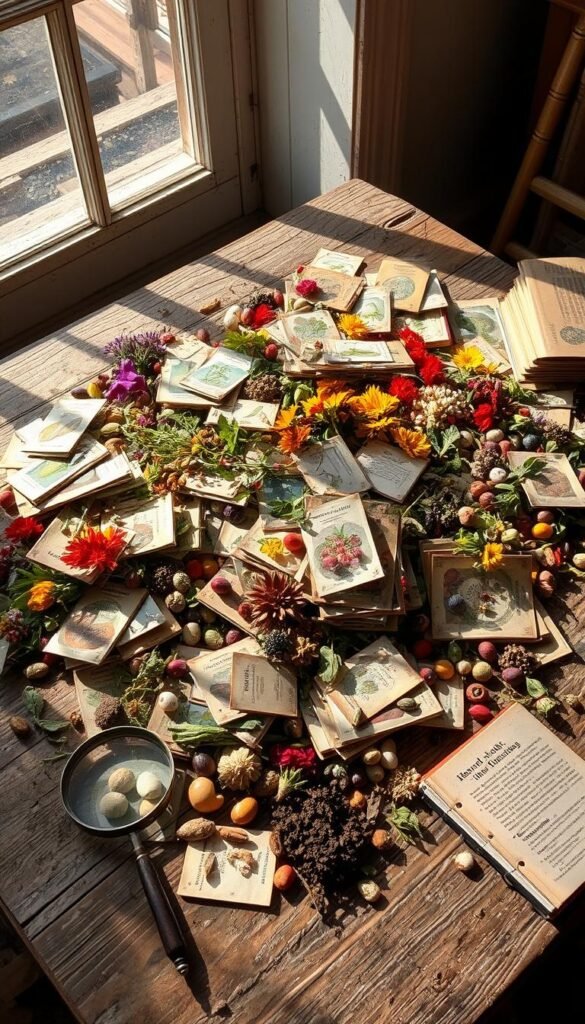
The secret to a thriving wild plot starts with your seed choices. Like matching puzzle pieces, the right combinations adapt to your local weather, soil type, and sunlight patterns. Think of it as curating a team where each plant supports the others.
Match Seeds to Your Environment
Check your USDA hardiness zone or ask nursery experts about native varieties. Drought-tolerant lavender thrives in sunny, dry areas, while mint prefers shady corners. Always prioritize plants that naturally grow well in your region’s conditions.
| Seed Type | Benefits | Ideal Conditions |
|---|---|---|
| California Poppies | Low water needs | Full sun, sandy soil |
| Chives | Repel pests | Partial shade, moist soil |
| Bush Beans | Enrich soil nitrogen | 6+ hours sun, well-drained |
Balance Your Mix
Combine fast-growers (like radishes) with slow-spreaders (zinnias) to prevent overcrowding. Pre-made seed mixes labeled “pollinator-friendly” or “shade blend” simplify planting. For DIY blends, pair plants with similar water and light needs.
Avoid aggressive spreaders like mint in small spaces—they’ll dominate. Instead, scatter seeds in layers: tall sunflowers at the back, creeping thyme up front. This creates depth while letting each variety shine.
Preparing and Protecting Your Garden’s Soil
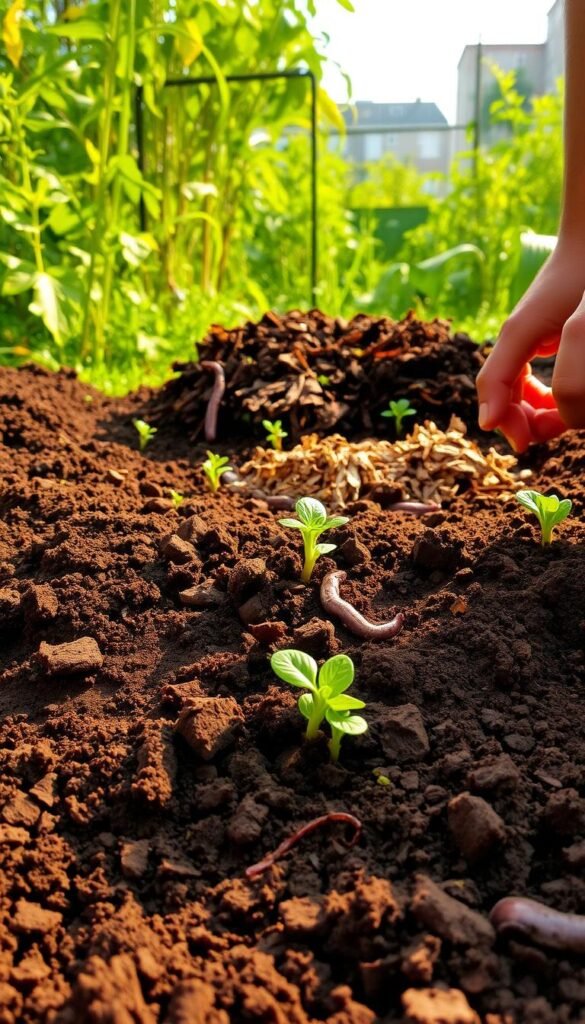
Healthy soil is the foundation of a thriving green space—even in urban settings. To create a resilient base for your plants, start by focusing on texture and nutrients. Loose, crumbly earth allows roots to spread and water to penetrate deeply, reducing runoff during heavy rains.
Soil Preparation Techniques
Begin by aerating compacted dirt with a garden fork or hand trowel. Break up clumps to create air pockets, which help seed germination and root growth. Mix in compost or aged manure to boost organic matter—this feeds microbes that keep your soil alive.
Consider layering living mulch like clover or creeping thyme. These low-growing plants shield bare patches, suppress weeds, and attract pollinators. For container beds, add perlite to improve drainage while retaining moisture.
| Organic Additive | Benefit | Best For |
|---|---|---|
| Compost | Enriches nutrients | All soil types |
| Coconut coir | Retains moisture | Potted plants |
| Leaf mold | Improves structure | Shaded areas |
Protect young sprouts by covering soil with burlap or straw until they establish. This shields against erosion and hungry birds. Over time, fallen leaves and spent blooms will decompose naturally, creating a self-renewing cycle.
Remember: Well-prepared earth needs less watering and fertilizing. By working with nature’s rhythms, you’ll build a fertile foundation where vegetables, flowers, and herbs can flourish unpredictably—and beautifully.
Timing and Weather Considerations
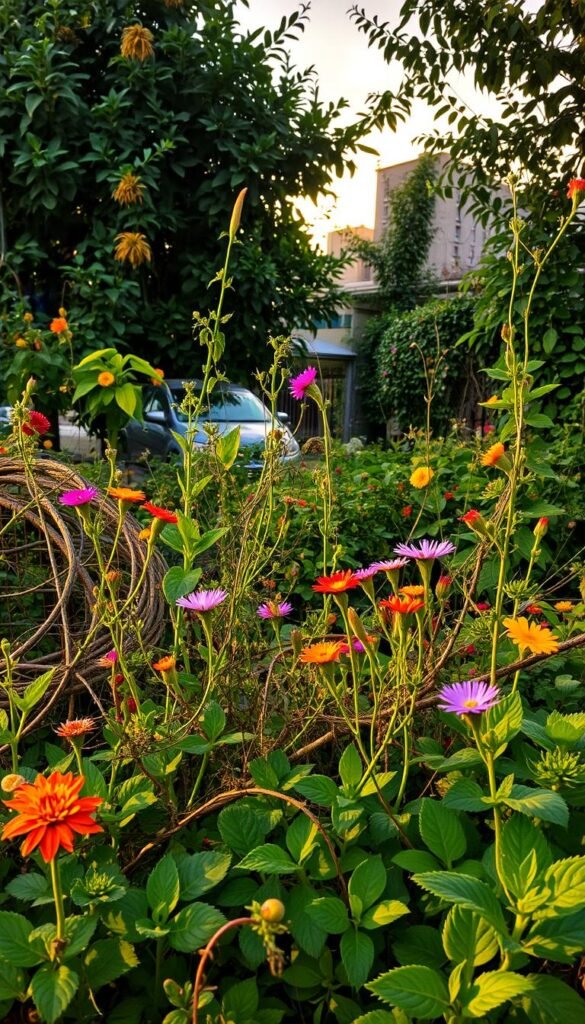
Timing is your secret weapon in creating a thriving wild oasis. Weather patterns and seasonal shifts directly impact which seeds sprout, how quickly they grow, and whether they’ll attract pollinators. Get this right, and your space becomes a self-renewing tapestry of flowers, herbs, and vegetables.
Optimal Planting Windows
Start by matching seeds to your region’s frost dates. Fast-growing varieties like arugula and radishes can go in early—even 4-6 weeks before spring’s last freeze. Wait until soil warms to 60°F for heat-lovers like zinnias or bush beans.
| Season | Seed Types | Key Tips |
|---|---|---|
| Early Spring | Spinach, peas, wildflower mixes | Plant as soon as soil is workable |
| Late Spring | Basil, sunflowers, marigolds | Wait for consistent 50°F+ nights |
| Summer | Drought-tolerant herbs, clover | Water deeply but less frequently |
Unexpected rain or heatwave? Adjust your plan. Scatter quick-sprouting seeds after storms to use moist soil. During dry spells, focus on native varieties that need less water. Check local forecasts weekly—nature’s surprises are part of the fun!
Remember: Overlapping planting times creates continuous blooms and harvests. Let some flowers go to seed in fall—they’ll drop naturally and pop up next year. Your garden becomes a living calendar, always changing yet perfectly in sync with the seasons.
Integrating Native Plants and Boosting Biodiversity
Your wild urban plot becomes a sanctuary when you invite local wildlife to join the party. Native plants act like welcome mats for bees, butterflies, and birds—creatures already adapted to thrive in your region’s climate. By choosing species that evolved in your area, you’ll create a resilient ecosystem that practically cares for itself.
Why Go Native?
Local varieties need less water and fertilizer because they’re built for your soil and weather. For example, milkweed feeds monarch caterpillars, while purple coneflowers draw hummingbirds. These plants also bloom when pollinators need them most, creating year-round food sources.
| Native Plant | Pollinator Attracted | Best Regions |
|---|---|---|
| Milkweed | Monarch butterflies | Midwest, Northeast |
| Purple Coneflower | Bumblebees | Plains, Southeast |
| Goldenrod | Solitary bees | Nationwide |
In Portland, a rooftop gardener saw swallowtail butterflies return after planting native lupines. Another in Phoenix reduced watering by 40% using desert marigolds. These gardens prove beauty and function coexist when you let nature lead.
Mix natives with your existing seed blends for pops of color and texture. Scatter wildflower packets around taller shrubs—uneven growth patterns keep the wild charm alive. Remember: every dandelion or clover patch adds character while supporting your local ecosystem.
Maintaining and Nurturing Your Chaos Garden
A wild garden doesn’t mean neglect—it’s about smart support that lets nature shine. Your role shifts from controller to observer, stepping in only when balance tips. This approach keeps your green space thriving while preserving its spontaneous charm.
Watering and Weeding Tips
New sprouts need gentle care. Water deeply at dawn using a targeted stream to reach roots without washing away seeds. Established plants? Let rain handle them unless soil cracks appear.
| Technique | Purpose | Best For |
|---|---|---|
| Soaker hose | Deep hydration | Dense plant clusters |
| Spray bottle | Seedling safety | Delicate herbs |
| Mulch layer | Moisture retention | Sun-baked areas |
Weed selectively. Remove invasive species choking other plants, but leave dandelions and clover—they aerate soil and feed bees. Use scissors to trim overgrown stems instead of uprooting.
Fostering Wildlife in Urban Spaces
Turn your plot into a critter sanctuary. Plant native blooms like goldenrod for butterflies and milkweed for monarchs. Add a shallow dish with stones for bees to drink safely.
| Native Plant | Wildlife Supported | Maintenance Level |
|---|---|---|
| Sunflowers | Birds (seeds) | Low |
| Lavender | Honeybees | Moderate |
| Ferns | Frogs (shade) | Minimal |
Install vertical structures like trellises for climbing vines—they double as bird perches. Avoid pesticides; let ladybugs handle aphids. Your wild corner becomes a living classroom where every visitor teaches resilience.
Overcoming Common Chaos Gardening Challenges
Even the wildest gardens need a little guidance to flourish. While unpredictability is part of the charm, overcrowding or aggressive species can disrupt your plot’s balance. Let’s tackle these hurdles while keeping the spirit of spontaneity alive.
Spotting and Solving Competition Issues
Plants compete for sunlight, water, and nutrients—especially when fast-growing varieties dominate. Look for stunted growth, yellowing leaves, or one species spreading rapidly. For example, mint can smother nearby herbs if left unchecked.
| Aggressive Plants | Cooperative Companions | Solution |
|---|---|---|
| Mint | Basil | Contain in pots |
| Sunflowers | Clover | Space 12” apart |
| Zucchini | Marigolds | Thin seedlings early |
Trim overcrowded areas with scissors instead of pulling roots. This preserves soil structure. If radishes crowd your carrots, harvest some young greens to create space—they’re tasty in salads!
Adjust your seed mix next season. Swap aggressive spreaders for slower growers like chamomile or thyme. For inspiration on balancing wildness with structure, explore adaptive urban green spaces.
Remember: Imperfections are part of the journey. Not every plant will thrive, and that’s okay. Celebrate the survivors, learn from the strugglers, and let curiosity guide your next planting experiment.
Embracing Flexibility and Creative Experimentation
Imagine your garden as a living canvas where every seed tells a story. This approach thrives on playful trial-and-error—toss unusual combinations into the mix and watch nature’s surprises unfold. Forget rigid rules; here, crooked carrot rows and clover-filled cracks become badges of honor.
Mix feathery dill with bold sunflowers, or let nasturtiums spill over rosemary bushes. A Chicago gardener once paired purple basil with wild strawberries—the result? Fewer pests and a buzzing pollinator party. You might discover kale thriving in partial shade or marigolds rescuing squash from beetles.
Mistakes? They’re just unplanned lessons. Overcrowded radishes become peppery microgreens. Wilting seedlings teach you about drainage. Each “oops” moment strengthens your green thumb intuition.
| Unexpected Pair | Benefit | Adaptation Tip |
|---|---|---|
| Tomatoes + Borage | Boosts growth | Trim borage if it overshadows |
| Lavender + Lettuce | Deters slugs | Water lettuce roots directly |
| Zinnias + Beans | Attracts bees | Use tall varieties as living stakes |
Flexibility breeds resilience. When storms flatten flowers, let them reseed. If herbs outgrow their space, harvest them for pesto parties. Your garden becomes a dance between intention and adaptation—where the best moments are those you never planned.
Wrapping Up Your Urban Gardening Journey
Your journey into untamed green spaces starts with a simple act: scattering seeds and trusting the process. By letting plants grow freely, you’ve discovered how wild beauty thrives in cracks, corners, and forgotten patches. Every twist of a vine or burst of color tells a story of resilience—yours and nature’s.
This approach isn’t about perfection. It’s a low-stress way to grow food, flowers, and community. When kale tangles with marigolds or herbs sprout sideways, you’re seeing ecosystems adapt. Challenges become lessons—crowded sprouts teach spacing, while uneven blooms reveal sunlight patterns.
Share your wins and surprises! Post photos of that rogue sunflower or swap seeds with neighbors. Together, we’re redefining what gardens look like in tight spaces. For more ideas on maximizing small areas, explore vertical growing hacks.
Now step back. Watch bees dance between clover and basil. Notice how soil improves where plants work together. Your plot isn’t just a garden—it’s proof that life finds a way, even in concrete jungles. Keep experimenting, learning, and letting nature take the lead. The wilder it gets, the more it feels like home.

